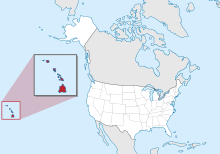
Paleontology in Hawaii refers to paleontological research occurring within or conducted by people from the U.S. state of Hawaii. The Hawaiian islands began to form as a result of volcanic activity about 5 million years ago during the Pliocene. Due to their young age and igneous geology, the islands preserve very few fossils. Most such remains are creatures like relatively recent corals and molluscs that lived in the area when sea levels were higher than they are today. Overall the state has seen very little paleontological research within its borders. According to author Marian Murray, prior to the 1974 publication of the second edition to her book Hunting for Fossils most of the little research on Hawaii's fossils record had already gone out of print. She recommended that would-be amateur fossil hunters in Hawaii consult staff of a local museum for clues on where to hunt due to the rarity of fossils and the lack of easily accessible information on them.[1]